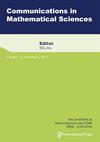A stochastic Galerkin method for the direct and inverse random source problems of the Helmholtz equation
IF 1.3
4区 数学
Q2 MATHEMATICS, APPLIED
引用次数: 0
Abstract
This paper investigates a novel approach for solving both the direct and inverse random source problems of the one-dimensional Helmholtz equation with additive white noise, based on the generalized polynomial chaos (gPC) approximation. The direct problem is to determine the wave field that is emitted from a random source, while the inverse problem is to use the boundary measurements of the wave field at various frequencies to reconstruct the mean and variance of the source. The stochastic Helmholtz equation is reformulated in such a way that the random source is represented by a collection of mutually independent random variables. The stochastic Galerkin method is employed to transform the model equation into a two-point boundary value problem for the gPC expansion coefficients. The explicit connection between the sine or cosine transform of the mean and variance of the random source and the analytical solutions for the gPC coefficients is established. The advantage of these analytical solutions is that the gPC coefficients are zero for basis polynomials of degree higher than one, which implies that the total number of the gPC basis functions increases proportionally to the dimension, and indicates that the stochastic Galerkin method has the potential to be used in practical applications involving random variables of higher dimensions. By taking the inverse sine or cosine transform of the data, the inverse problem can be solved, and the statistical information of the random source such as the mean and variance can be obtained straightforwardly as the gPC basis functions are orthogonal. Numerical experiments are conducted to demonstrate the efficiency of the proposed method.亥姆霍兹方程直接和反向随机源问题的随机伽勒金方法
本文研究了一种基于广义多项式混沌(gPC)近似的新方法,用于解决带有加性白噪声的一维亥姆霍兹方程的直接和逆随机源问题。直接问题是确定随机源发出的波场,而逆问题则是利用不同频率波场的边界测量值来重建源的均值和方差。随机亥姆霍兹方程的重新表述方式是用一组相互独立的随机变量来表示随机源。采用随机伽勒金方法将模型方程转化为 gPC 扩展系数的两点边界值问题。随机源的均值和方差的正弦或余弦变换与 gPC 系数的解析解之间建立了明确的联系。这些解析解的优势在于,对于阶数大于 1 的基多项式,gPC 系数为零,这意味着 gPC 基函数的总数与维数成正比增加,表明随机伽勒金方法有可能用于涉及更高维度随机变量的实际应用。通过对数据进行正弦或余弦逆变换,可以求解逆问题,由于 gPC 基函数是正交的,因此可以直接获得随机源的统计信息,如均值和方差。通过数值实验证明了所提方法的高效性。
本文章由计算机程序翻译,如有差异,请以英文原文为准。
求助全文
约1分钟内获得全文
求助全文
来源期刊
CiteScore
1.70
自引率
10.00%
发文量
59
审稿时长
6 months
期刊介绍:
Covers modern applied mathematics in the fields of modeling, applied and stochastic analyses and numerical computations—on problems that arise in physical, biological, engineering, and financial applications. The journal publishes high-quality, original research articles, reviews, and expository papers.

 求助内容:
求助内容: 应助结果提醒方式:
应助结果提醒方式:


